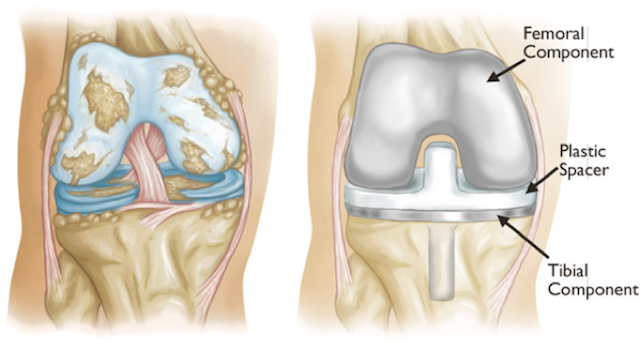
The knee joint is an articulation between three bones. This is formed between the lower end of femur (thigh bone), upper end of tibia (leg bone) and the knee cap (patella). There is a special smooth lining at the joint ends of these bones, which is called the articular cartilage. Arthritis would result, when there is destruction of the articular cartilage, either primarily due to ageing or secondarily due to trauma, inflammation.
The joint becomes painful, swollen and deformed (bowleg or knock knee). In the early stages the symptoms are mild and intermittent. In later stages the symptoms of pain would increase
In the early stages the options are using safe painkillers (safe to the kidneys and stomach), physiotherapy, injection of local steroids / visco supplementation, use of kneecaps and walking aids.
Surgical treatment would be indicated in severe osteoarthritic changes, which is not responding to non-operative measures.
The artificial components are made of Metal alloys such as cobalt chromium, titanium alloys and special plastic called ultrahigh molecular weight polyethylene. The actual movement occurs between the metal alloy and the plastic.
Most of the times bone cement (poly-methylmethacrylate) is used to fix these components. One could also fix these components without using cement but then these components would have special coating (porous coating).
The three compartments of the knee are the medial compartment (inner side), lateral compartment (outer) and patellofemoral compartment.
In partial knee replacement as name indicates only one of the three compartments of the knee is replaced.
A total knee replacement is when all three compartments of the knee are replaced. This is obviously indicated when two or more compartments are affected with osteoarthritis.
A well-done total knee replacement would last average 15–20 years.
A good comparison would be to compare this to the procedure of changing car tyres. To get maximum mileage out of the tyres, we make sure that the wheels are aligned properly before fixing set of new tyres and equally important we make sure that we use high quality tyres so that they last longer.
Similarly, in osteoarthritis the normal weight-bearing axis of the leg, is distorted. Normal weight bearing axis of the leg is a line, which passes through the center of the ankle, knee and hip. It is very important that this axis is corrected to optimal value. From evidences we know that if this weight bearing axis is corrected to within ±3° then the joint would last longer.
Also using a high quality artificial joint, which has stood the test of time, is important. One would get unbiased data from the joint registries (such as Swedish, Australian, UK joint registries) as to which particular design of the artificial joint is doing the best when it comes to long-term survival.
Although total knee replacement is a very successful surgery, there are risks involved
- Normally blood doesn’t clot within our system, but following any major surgeries around pelvis and lower limbs the blood could clot within the blood vessels and cause localized swelling of legs this is called deep vein thrombosis.
- This could become loose and could propagate ending up in the lungs causing serious condition called pulmonary embolism (0.1 %).
- The risk of infection is about 1 %, it is slightly higher in patients who are diabetic, rheumatoid arthritis. The other complications would be blisters.
The hospital stay would be approximately four or five days following a single joint replacement. Following bilateral total knee replacement the stay would be 7 to 10 days.
Most of the times a Spinal anaesthesia would be given but sometimes a general anaesthetic would also be used. The anaesthesiologist would evaluate and administer the most appropriate anaesthetic.
